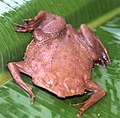 | Aquatic feeding mechanisms face a special difficulty as compared to feeding on land, because the density of water is about the same as that of the prey... 26 KB (3,166 words) - 06:53, 1 March 2024 |
 | Filter feeder (redirect from Filter feeding) Filter feeders are a sub-group of suspension feeding animals that feed by straining suspended matter and food particles from water, typically by passing... 26 KB (3,148 words) - 06:07, 26 April 2024 |
 | Ramírez, Alonso; Gutiérrez-Fonseca, Pablo (2014). "Functional feeding groups of aquatic insect families in Latin America: a critical analysis and review... 8 KB (884 words) - 04:27, 19 February 2024 |
 | Bottom feeder (category Aquatic animals) that refer to bottom feeding fish, such as demersal fish, groundfish, benthic fish and benthopelagic fish. Examples of bottom feeding fish species groups... 8 KB (910 words) - 04:28, 17 November 2023 |
 | Energy flow (ecology) (section In aquatic environments) production. Top-down mechanisms exert greater control on aquatic primary producers due to the roll of consumers within an aquatic food web. Among consumers... 31 KB (3,546 words) - 11:57, 16 April 2024 |
 | Drepanaspis (section Feeding Ecology) an aquatic feeding mechanism called suction feeding. The suction feeding mechanism of Drepanaspis was likely a specialized adaptation for feeding on small... 20 KB (2,042 words) - 07:29, 3 March 2024 |
 | Salamander (redirect from Feeding behavior of salamanders) PMC 8053045. PMID 33928143. Toews, Daniel P. (1974). "Respiratory Mechanisms in the Aquatic Salamander, Amphiuma tridactylum". Copeia. 1974 (4): 917–920.... 98 KB (11,027 words) - 23:20, 29 April 2024 |
 | Amphibian (section Defence mechanisms) allowed tadpoles to adopt a filter feeding lifestyle, even if several species have since evolved other types of feeding strategies. The lungs develop early... 158 KB (17,759 words) - 16:52, 11 April 2024 |
 | Zooplankton (redirect from Sloppy feeding) 'plant'). Zooplankton are heterotrophic (other-feeding), whereas phytoplankton are autotrophic (self-feeding), often generating energy through photosynthesis... 76 KB (7,030 words) - 05:39, 28 April 2024 |
Skeletal changes of vertebrates transitioning from water to land (section Teeth and feeding mechanisms) sutural deformation is caused by strain during feeding activity, most prominent with feeding mechanisms involving sucking a prey into the mouth. There... 20 KB (2,761 words) - 07:00, 19 January 2022 |
 | Isopoda (section Feeding and nutrition) parasites, and filter feeders, and may occupy one or more of these feeding niches. Only aquatic and marine species are known to be parasites or filter feeders... 32 KB (3,641 words) - 22:56, 23 April 2024 |
 | lakes, and start the adult hematophagous method of feeding. Some individuals start hematophagous feeding in the river before migrating to the sea, where... 28 KB (3,090 words) - 00:58, 19 March 2024 |
 | Marshall Editions. p. 71. ISBN 1-84028-152-9. Rieppel, O. (2002). Feeding mechanisms in Triassic stem-group sauropterygians: the anatomy of a successful... 5 KB (627 words) - 03:48, 3 March 2024 |
 | Herbivore (section Feeding strategies) herbivores is uncertain. Hole feeding and skeletonization are recorded in the early Permian, with surface fluid feeding evolving by the end of that period... 53 KB (6,209 words) - 17:22, 10 April 2024 |
 | Planktivore (section Feeding strategies) organisms that feed upon plankton. Planktivory can be an important mechanism of top-down control that contributes to trophic cascades in aquatic and marine... 72 KB (8,392 words) - 00:23, 7 April 2024 |
 | Sea louse (section Feeding habits) copepodid stages are non-feeding and live on endogenous food stores. Once attached to the host, the copepodid stage begins feeding and begins to develop... 50 KB (6,005 words) - 14:46, 13 March 2024 |
 | Common Surinam toad (section Feeding behavior) to come into range, which it then captures using suction feeding. P. pipa is a strictly aquatic frog and the largest member of its genus. The species has... 19 KB (2,274 words) - 19:39, 14 April 2024 |
 | Utricularia (section Trapping mechanism) (0.008 to 0.5 in). Aquatic species, such as U. vulgaris (common bladderwort), possess bladders that are usually larger and can feed on more substantial... 42 KB (4,955 words) - 22:43, 27 April 2024 |
 | the bait is not consumed. Snails and slugs which feed on or ingest ferric sodium EDTA stop feeding almost immediately after exposure, and die within... 4 KB (344 words) - 19:02, 26 August 2023 |
 | among cnidarians, ctenophores, echinoderms, molluscs and several other aquatic animal phyla as well. (True) oviparity, in which fertilization is internal... 5 KB (641 words) - 15:56, 30 April 2024 |
 | and dorsal fins. Wild guppies generally feed on a variety of food sources, including benthic algae and aquatic insect larvae. Guppies are used as a model... 56 KB (6,117 words) - 05:34, 16 April 2024 |








